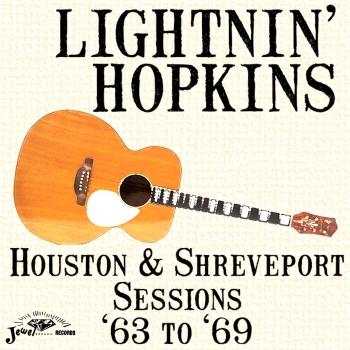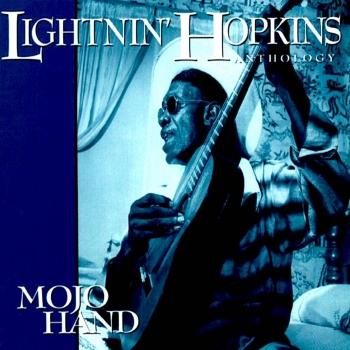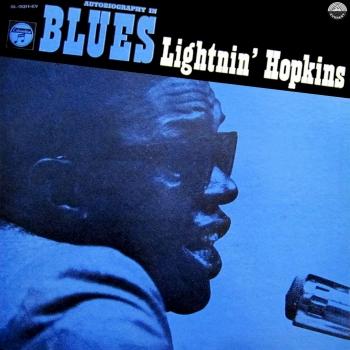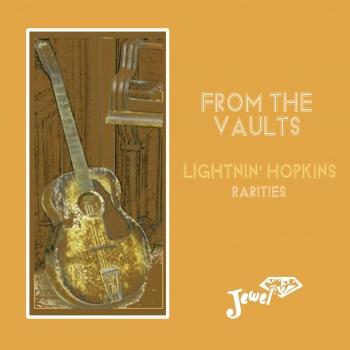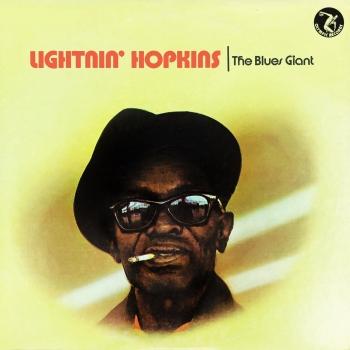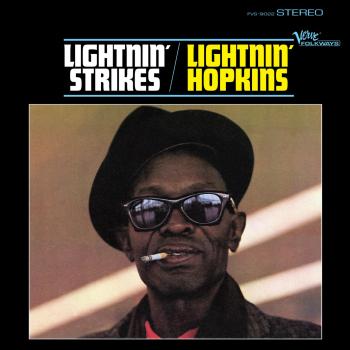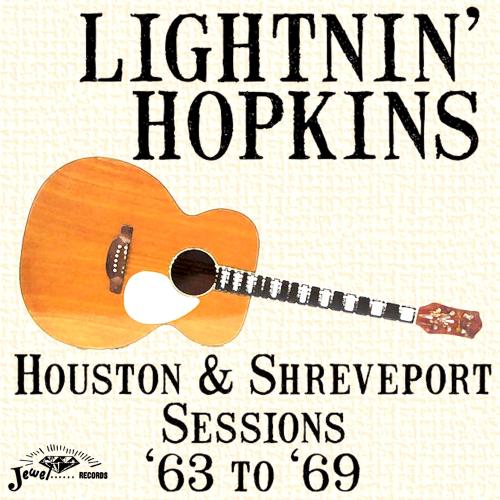
Houston & Shreveport Sessions '63 to '69 (Remastered) Lightnin' Hopkins
Album info
Album-Release:
1969
HRA-Release:
08.01.2019
Album including Album cover
- 1 Mojo Hand (1966 Version) 03:33
- 2 Gamblers Blues 04:01
- 3 Fishing Clothes 03:39
- 4 Mr. Charlie, Pt. 1 02:20
- 5 Mr. Charlie, Pt. 2 02:38
- 6 Evil Hearted Woman 02:42
- 7 Lightnin' Jump 02:29
- 8 Ride in You New Automobile 04:12
- 9 Little School Girl 04:48
- 10 Death in the Family 04:57
- 11 Late in the Evening 02:48
- 12 Born in the Bottoms 05:25
- 13 I Feel Like Balling the Jack 02:53
- 14 Go Ahead 03:11
- 15 I Wonder Where She Can Be Tonight 04:01
- 16 Moving Out 03:35
- 17 Crying for Bread 05:47
- 18 Rainy Day in Houston 05:03
- 19 Lonesome Life 03:29
- 20 Pine Gum Boogie 03:30
- 21 How Does It 02:41
- 22 Got a Letter This Morning 02:51
- 23 My Daddy Was a Preacher Man 04:03
- 24 Stinking Foot 02:54
- 25 Walking and Walking 03:16
- 26 Balling the Jack 02:53
- 27 The World's in a Tangle 03:19
- 28 Last Affair 02:59
- 29 Lonesome Dog Blues 02:40
- 30 Found My Baby Crying 03:58
- 31 Move on out, Pt. 1 02:55
- 32 Morning Blues 04:38
- 33 Wig Wearing Woman 03:44
- 34 Gamblers Blues (Session) 04:00
- 35 Rock Me Baby (Take 1) 04:54
- 36 War is Starting Again 03:01
- 37 Play with Your Poodle (Take 1) 02:02
- 38 Old Man 00:57
- 39 Good as Old Time Religion 03:14
- 40 You're Too Fast 03:44
- 41 Love Me This Morning 03:24
- 42 Got Me a Louisiana Woman 02:56
- 43 I'm Comin' Home 02:51
- 44 Breakfast Time 03:11
- 45 Lightnin' Strikes One More Time 02:51
- 46 You Just Got to Miss Me 04:00
- 47 A Man Like Me is Hard to Find 04:41
- 48 Mini Skirt 03:09
- 49 Backwater Blues (This Mean Old Twister) 02:45
- 50 Vietnam War 03:45
- 51 Wake up the Dead 02:46
Info for Houston & Shreveport Sessions '63 to '69 (Remastered)
Texas bluesman Lightnin’ Hopkins career was both long and fruitful. He performed live for six decades and recorded for over 30 years amassing a catalogue that was larger than almost any of his contemporaries. Not only was he prolific but he was also a great raconteur and a very good live performer with an ‘act’ honed to perfection at pre-war dances and parties. His guitar playing was unconventional, some have even called it ragged, but it is not as a guitarist that he will be remembered. Somehow the way he set his songs seemed totally apposite and it gave everything he did an authenticity that few others were ever able to match.
Born Sam Hopkins on 15 March 1912, his father was a musician who died when Sam was very young. The family moved to Leona in Texas where he grew up; in 1920 he watched Blind Lemon Jefferson at a picnic in Buffalo, Texas, which inspired him to make a ‘cigar box’ guitar. His older brother Joel taught him to play the homemade guitar before his mother, Frances, encouraged him to play organ at her home church services. However, he was drawn to the music played by his older brothers Joel and John Henry. He soon dropped out of school and started work on a plantation. “I did a little plowin’ – not too much, chopped a li’l cotton, pulled a li’l corn. I did a little of it all.” He, like many other bluesmen, began playing at picnics and dances at local farms on a Friday and Saturday night; later he took to hoboing throughout Texas.
"Lightnin' Hopkins' many albums are remarkably consistent (or all of them sound the same, depending on the way you want to phrase it), featuring his semi-improvised autobiographical lyrics sung over a stock set of slow blues riffs, with the occasional speeded-up boogie tossed in, and now and then a turn at the piano. Whether Hopkins played acoustic or electric guitar really didn't make much difference in his sound, Lightnin' was Lightnin' either way. While this set of recordings he made for New York-based Herald Records (the actual sessions were held in Houston) in 1954 with drummer Ben Turner and bassist Donald Cooks doesn't deviate much from the stock Hopkins template, it is particularly sharp, featuring some of the best electric guitar he ever played. The songs themselves are short, sweet, and to the point, often trailing off after a couple of verses, which gives sides like "Life I Used to Live" an added poignancy while adding an intangible sincerity to cuts like "Don't Think Cause You're Pretty." Hopkins also amps up on guitar more than usual, particularly with the blistering "Hopkins' Sky Hop," making the Herald recordings essential for Hopkins fans. Lightnin' cut 26 tracks at the sessions, 12 of which were originally released on LP as Lightnin' and the Blues in 1960, and then reissued in that sequence numerous times under different titles, including My Baby's Gone in 2005 by Fruit Tree Records, and simply as Lightnin' Hopkins by Dressed to Kill in 2001. Buddha released Lightnin' and the Blues in 2001 with four bonus tracks from the sessions added, while London's Ember Records collected all 26 Herald sides on one disc as Remember Me in 2000. Whatever the version, these are some of the best and most focused tracks Lightnin' Hopkins ever cut." (Steve Leggett, AMG)
Digitally remastered
Sam Lightnin' Hopkins
Born in Centerville, Texas, Hopkins learned the blues when young in Buffalo, Texas from Blind Lemon Jefferson and his older cousin, country-blues singer Alger 'Texas' Alexander. When Hopkins and Alexander were playing in Houston in 1946, he was discovered by Lola Anne Cullum of Los Angeles', Aladdin Records (although Alexander would not make it out to L.A.) Hopkins' fast finger style is very distinct.
He settled in Houston in 1952 and gained much attention. Solid recordings followed including his masterpiece song Mojo Hand in 1960.
His style was born from spending many hours playing informally without a backing band. His distinctive style often included playing, in effect, bass, rhythm, lead, percussion, and vocals, all at the same time. His musical phrasing would often include a long low note at the beginning, the rhythm played in the middle range, then the lead in the high range. By playing this quickly - with occasional slaps of the guitar - the effect of bass, rhythm, percussion and lead would be created.
In 1968 Hopkins recorded the album Free Form Patterns backed by psychedelic rock band the 13th Floor Elevators.
Hopkins was a great influence on many local musicians around Houston and Austin, Texas in the 1950s and 1960s. He was an influence on Jimmie Vaughan's work and, more significantly, on the vocals and blues style of Ron "Pigpen" McKernan, the keyboardist of the Grateful Dead until 1972. He was also an important influence on Townes Van Zandt, the Texan folk/blues songwriter and performer, who often performed Hopkins numbers in his live performances. Doyle Bramhall II is another Texas artist who was influenced by Hopkins, as evidenced by a tattoo of Lightning on his upper left arm. Jimi Hendrix reportedly became interested in blues music listening to Lightnin' Hopkins records with his father.
A song named after him was recorded by R.E.M. on their album Document.
The Houston Chronicle included Hopkins in their list of "100 Tall Texans", 100 important Texans that influenced the world. The George Bush Presidential Library and Museum included Hopkins in a 100 Tall Texans exhibit that opened in September 2006. The display includes Lightnin's Guild Starfire electric guitar and performance video.
Hopkins' Gibson J-160e guitar is on display at the Rock n' Roll Hall of Fame in Cleveland, Ohio. Sam "Lightnin'" Hopkins (March 15, 1912 – January 30, 1982).
This album contains no booklet.











